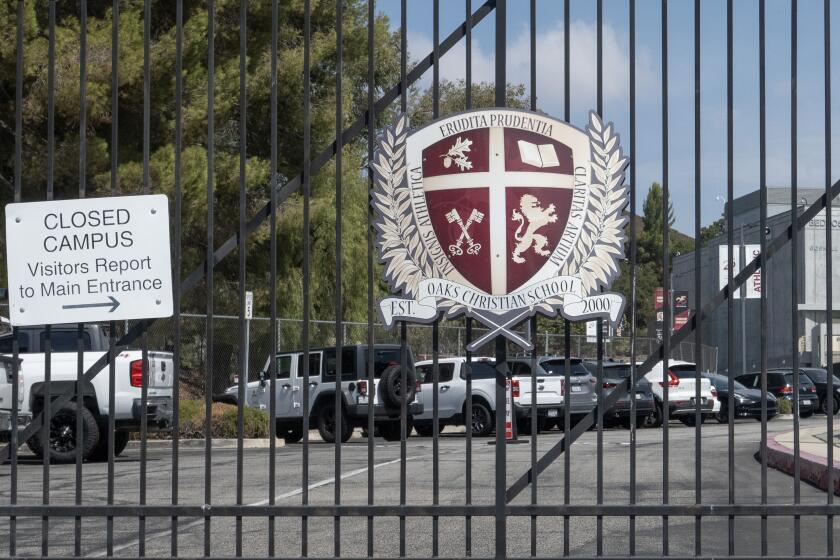Shaken Loose : Quake Restoration Separates Adobe, Octogenarian Caretaker
For the past 12 years, for better or for worse, the Lopez Adobe, a crumbling, historic building owned by the city of San Fernando, and Albert Weinmann, an ailing and aged carpenter, have been joined in a kind of common-law marriage.
Weinmann never had a contract with the city, never paid rent and never received a salary. But he lived in the two-story, Victorian-style adobe nonetheless, tending to the general maintenance needs of the 115-year-old building and acting as a round-the-clock watchman.
He sometimes gave tours of the building and helped to register guests three days each week, when the adobe was open to the public.
But when city officials prepared to launch a $200,000 restoration of the quake-battered house, they faced a quandary concerning the octogenarian caretaker. Weinmann, they said, could not continue to stay in the building, which has an electronic alarm system, during the project, which would include replacing the partially collapsed roof and brick chimney, shoring up the thick adobe walls and making other major improvements.
Ultimately, the city told Weinmann to move out of the adobe, citing his failing health, the lack of a formal agreement with Weinmann to provide services to the city and saying his continued residence in the sagging, creaking building posed a potential liability risk.
“There’s concern about his health,” said Ed Montan, director of the city parks department. “We felt he’d be better off where he could get immediate medical attention if he needed it.”
Other officials noted that several burglaries took place at the adobe and that at least one occurred while Weinmann was at home.
Weinmann, 83, a diabetic who has a pacemaker for his heart condition, acknowledged that his residence in the building for the past 12 years was never officially sanctioned by the city.
“I needed a place to live and I just moved in. Nobody ever said nothing,” he said. “If the quake hadn’t hit, they’d probably never bothered me.”
*
Weinmann became involved with Lopez Adobe when his cousin Martha Molitz asked him to build some display cases for antiques and other Victorian-era pieces donated by philanthropists to furnish the building after the city purchased it in 1970.
“Martha had me building cabinets for the displays,” Weinmann said. “She’s the one who got me mixed up in the place.” The San Fernando Historical Site and Preservation Commission approved his residency there.
Recently, on a slow tour of the adobe’s ground floor, Weinmann proudly pointed out the dozen-odd cabinets and display cases, their artifacts now cleared for an inventory, that he crafted. “I built a lot of the things you see around here,” he said, waving his cane in the air.
Though he’s moving just four blocks away into a garage converted into a rental unit, Weinmann said he’ll miss his life in the old adobe. The city’s “no questions asked” policy had allowed him to live quietly and blissfully in the three-bedroom building, a registered National Historic Site and little-known, but important California landmark.
The adobe’s original owners were Geronimo and Catalina Lopez, two early settlers of the northern San Fernando Valley. Catalina’s father once was mayordomo of San Fernando Mission, and her husband, Geronimo, was a messenger for Gen. Andres Pico of the Mexican Army.
Geronimo Lopez delivered the letter of truce to U.S. Gen. John C. Fremont in 1847, ending the war between Mexico and the United States. The property remained family owned until 1970, when the city purchased it to save it from destruction.
Now, the adobe at 1100 Pico St. sits behind stores on the city’s main street, down the block from the local Goodwill center, its immaculately landscaped, lush flora partially obscuring the faded turquoise paint on the front porch.
Over the past few years, Weinmann has spent most days in the adobe’s kitchen watching television. He has an artificial leg below the left knee, so he doesn’t get around too well, and he can’t seem to remember the last thing he fixed around the place.
Some excitement would come when transients knocked on the back door. Weinmann usually gave them money, if he had any, and let them sleep in the back yard, under the trellis next to the Thorn of Christ cactus plant.
He remembered a little girl and her mother and father, who occasionally slept in the old, open-air fire place. He hasn’t seen them since the Northridge quake, when the adobe’s brick chimney collapsed. None of the homeless people ever caused him any trouble, though once he woke up to the sound of a running garden hose outside his window. When he looked out, a buck naked fellow was taking a shower.
“He said he felt really dirty and wanted to get clean,” said Weinmann, who took the surprise visitor in stride, in much the way he took his eviction by the city.
“It was time for me to leave,” he said, adding that he never felt unsafe in the adobe, even during the three burglaries. Each time, Weinmann said, the thieves stole his television. Once, they took some items from a display cabinet. Once, a startled burglar ran right by his bed.
*
So, Weinmann and the old adobe will part ways, though Carolyn Riggs, curator at the adobe, has asked him to come back three days a week after it reopens, to sit near the entrance and register visitors.
“I lived here too long anyway,” joked Weinmann, picking his way slowly through the sala , or living room. Using his cane, he navigated cautiously through a maze of crates, wrapping paper and pieces of china spread over the floor for inventory and packing by a curatorial service.
“It wasn’t really that convenient,” he said.
More to Read
Sign up for Essential California
The most important California stories and recommendations in your inbox every morning.
You may occasionally receive promotional content from the Los Angeles Times.










